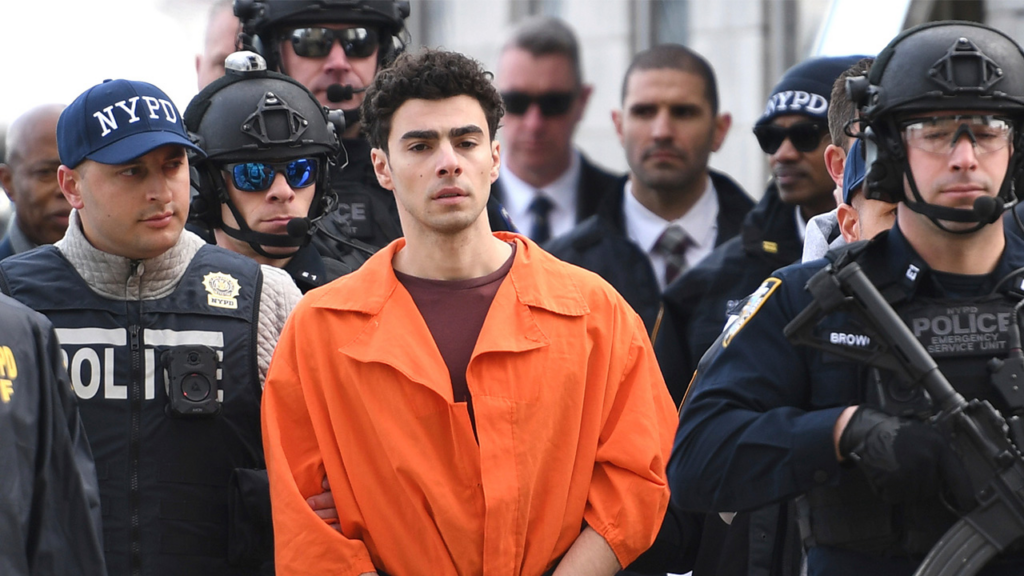Luigi Mangione is more complicated than his myth. The internet doesn’t care.
It used to be that when a killer emerged in America, we found out who the man was before we began to enshroud him in myth. But with Luigi Mangione, the lead suspect in the killing of UnitedHealthcare CEO Brian Thompson, that process was reversed. The internet assumed it already knew everything about Thompson’s killer before a suspect had even been identified, let alone arrested.
Within hours of the shooting, social media was churning out a mythologized version of the masked man. In his anonymity, he became an instant folk hero, portrayed as a crusader for universal healthcare, a martyr willing to risk it all to send a message to America’s insurance giants with “the first shots fired in a class war.” A Reddit forum offered up dozens of laudatory nicknames to crystalize his mythology: the Readjuster, the Denier, the People’s Debt Collector, Modern-Day Robin Hood. “I actually feel safer with him at large,” one tweet a day after the shooting said; it received 172,000 likes. A surveillance image of the suspect moved some to comment that he was “too hot to convict” and prompted comparisons to Jake Gyllenhaal and Timothée Chalamet. In New York City, a “CEO-shooter look-alike competition” was held in Washington Square Park. Surely, the internet assumed, the suspect shared left-wing ideas about the cruelties of privatized healthcare.
Then the man himself appeared — and he didn’t fit into any of the neat categories that had already been created to describe him. On X, he followed the liberal columnist Ezra Klein and the conservative podcaster Joe Rogan. He respected Alexandria Ocasio-Cortez and retweeted a video of Peter Thiel maligning “woke”-ism. He took issue with both Donald Trump and Joe Biden. He played the cartoon video game “Among Us,” posted shirtless thirst traps, quoted Charli XCX on Instagram, and had the Goodreads account of an angsty, heterodox-curious teenage boy: self-help, bro-y nonfiction, Ayn Rand, “The Lorax,” and “Infinite Jest.” Yes, he seemed to admire the Unabomber. But mostly, this guy — a former prep-school valedictorian with an Ivy League education and a spate of tech jobs — was exceedingly centrist and boring. A normie’s normie. He wasn’t an obvious lefty, but he wasn’t steeped in the right-wing manosphere either. His posted beliefs don’t fit neatly into any preestablished bucket. In his 261-word manifesto, which surfaced online, he downplayed his own qualifications to critique the system. “I do not pretend,” he wrote, “to be the most qualified person to lay out the full argument.”

That didn’t stop the denizens of social media from pretending to be the most qualified people to lay out exactly who Mangione is. He’s “fundamentally anti-capitalist” and “just another leftist nut job.” Or he’s “a vaguely right-wing ivy league tech bro.” Or he was invented by the CIA, or maybe Mossad, as a “psyop.” The reality of Mangione — his messy, sometimes contradictory impulses — allowed everyone to cherry-pick the aspects of his personality that confirmed their original suspicions. In the attention economy, patience is a vice.
The rush to romanticize killers is nothing new. A quarter century ago, we cast the Columbine shooters as undone by unfettered access either to guns or to the satanic influences of Marilyn Manson and Rammstein. A decade ago, we debated the glamorization of the Boston Marathon bomber, gussied up like a rock star on the cover of Rolling Stone. But social media has sped up the assumption cycle to the point where we put the killer into a category before police have found the killer. Perhaps there’s a “great rewiring” of our brains that has diminished our capacity to understand each other, as the social psychologist Jonathan Haidt suggests in “The Anxious Generation” — a book Mangione had retweeted a glowing review of.

Mythmaking is easier, of course, when it’s unencumbered by reality. The less we know about a killer, the more room there is to turn him into something he’s not. From what we have learned so far, Mangione is a troubled Gen Zer who won the privilege lottery at birth and ascribed to a mishmash of interests and beliefs. We will surely learn more about him in the coming days, weeks, and months. But now that we know who he is, it will be hard, if not impossible, to let go of our initial assumptions. Instead, we’ll selectively focus on the details that fit tidily into the myths we’ve already created. In the digital-age version of “The Man Who Shot Liberty Valance,” the legend was already printed by the time the facts came along.
Scott Nover is a freelance writer in Washington, DC. He is a contributing writer at Slate and was previously a staff writer at Quartz and Adweek covering media and technology.
It’s now officially official: The U.S. is getting the 2026 Honda Prelude. While the news isn’t a surprise, it had only been strongly hinted at up to today, when Honda confirmed as much. The hybrid two-door Honda coupe will arrive on our shores later in 2025 and will do its best to keep up the performance end suggested by its appearance despite its humble-origins hybrid system shared with the Civic, Accord, and others.
Key to this performance feel will be the use of a seemingly Prelude-exclusive (for now) Linear Shift Control, which Honda says will give the coupe “the feel of a conventional drivetrain shifting gears” at wide open throttle. While this sounds utterly banal, it’s actually big news given the way Honda’s current hybrid setup works: There is no conventional type of transmission between the drive wheels and the engine, certainly not one that can be “shifted” from gear to gear in the traditional sense. Instead, a large electric motor does most of the motivation, while the gas engine feeds power to it via a smaller motor-generator unit; the engine can be clutched into a single-speed direct-drive gearbox to help assist the drive wheels in certain scenarios where it’s deemed more efficient to do so. Thus any “shifting” would be entirely faux, much like the simulated rev dips in the Honda Civic and Accord Hybrid models; it’s not yet clear whether Linear Shift Control differs from that programming in any way, though it could by handing over control over those “shift” points to the driver. This also confirms our suspicion that Honda wouldn’t be able to release a true manual or even a DCT version of the Prelude while using its hybrid powertrain.
This “Linear Shift Control” will be joined by a new driving mode called “S Plus Shift,” stylized as “S+ Shift.” Again, according to Honda, this will improve the feel of the 2026 Prelude by maximizing “the efficiency of a high-performance engine and high-output motor, finely controlling engine RPM across all acceleration and deceleration ranges based on driving conditions.” This aggressive feeling is matched to an active sound controller for “powerful auditory feedback” and “responsive meter that engage the senses.”
Honda clued us in to this system during the Honda 0 prototype drives back in October, but at the time it said to expect this auditory system to be released on all-electric Hondas by 2028. It seems like Honda has created a version that can be applied right now to the 2026 Prelude, and we expect a version dedicated to full electrics in the coming years.



